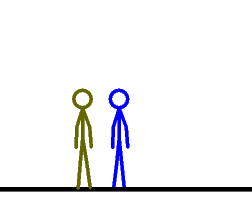

Leapfrog is a children's game in which players vault over each other's stooped backs.


Leapfrog is a children's game in which players vault over each other's stooped backs.
Games of this sort have been called by this name since at least the late sixteenth century. [1]
The first participant rests their hands on knees and bends over sideways, which is called giving a back. The next player places hands on the first's back and leaps over by straddling legs wide apart on each side. On landing he stoops down and a third leaps over the first and second, and the fourth over all others successively. When all the players are stooping, the last in the line begins leaping over all the others in turn. The number of participants is not fixed.

The French version of this game is called saute-mouton (literally "leapsheep"), and the Romanian is called capra ("mounting rack" or "goat"). In India it is known as "Aar Ghodi Ki Par Ghodi" (meaning "horseleap"). In Italy the game is called "la cavallina" (i.e. "small or baby female horse"). In Dutch it is called "bokspringen" (literally "goatjumping"; a 'bok' is a male goat) or "haasje-over" (literally "hare-over").
In China this game is known as "跳山羊"(literally[ citation needed ] "leap goat"), which is played in pairs. One player, acting as "the goat", leaps over the back of the other player, who plays the role of "the rock/mountain". Then they switch roles, and "the rock" rises a bit each time they switch. Both players continue playing until one "goat" fails leaping "the rock/mountain" as the result of its rising. In the Filipino culture, a similar game is called luksóng báka (literally "leap cow"), in which the "it" rests his hands on his knees and bends over, and then the other players—in succession—place their hands on the back of the “it” and leaps over by straddling legs wide apart on each side; whoever's legs touch any part of the body of the “it” becomes the next “it.” In the Korean and Japanese versions (말뚝박기 lit. "piledriving" and 馬跳びうまとびumatobi, lit. "horseleap", respectively), one player 'leaps' over the backs of the other players who stoop close enough to form a continuous line, attempting to cause the line to collapse under the weight of the riders.

A sex position is a positioning of the bodies that people use to engage in sexual intercourse or other sexual activities. Sexual acts are generally described by the positions the participants adopt in order to perform those acts. Though sexual intercourse generally involves penetration of the body of one person by another, sex positions commonly involve non-penetrative sexual activities.
Because ballet became formalized in France, a significant part of ballet terminology is in the French language.
Professional wrestling throws are the application of professional wrestling techniques that involve lifting the opponent up and throwing or slamming them down. They are sometimes also called "power" maneuvers, as they are meant to emphasize a wrestler's strength. Many of these moves are used as finishers by various wrestlers, who refer to them by several different names that reflect their gimmick. Moves are listed under general categories whenever possible.
Professional wrestling holds include a number of set moves and pins used by performers to immobilize their opponents or lead to a submission. This article covers the various pins, stretches and transition holds used in the ring. Some wrestlers use these holds as their finishing maneuvers, often nicknaming them to reflect their character or persona. Moves are listed under general categories whenever possible.
Strikes can be offensive moves in professional wrestling, that can sometimes be used to set up an opponent for a hold or for a throw. There are a wide variety of strikes in pro wrestling, and many are known by several different names. Professional wrestlers frequently give their finishers new names. Occasionally, these names become popular and are used regardless of the wrestler performing the technique.

In professional wrestling, a pin is a move where a wrestler holds an opponent's shoulders to the mat. A pinfall is a common victory condition, where the attacker pins an opponent and the referee makes a three count before the opponent gets released from the pin.

Chinese jump rope, also known as Chinese ropes, jumpsies, elastics, rek, yoki (Canada), Super Cali (Newfoundland), French skipping, American ropes/Chinese ropes, gummitwist, "jeu de l elastique" in France and Chinese garter in the Philippines is a children's game resembling hopscotch and jump rope. Various moves are combined to create patterns which are often accompanied by chants.
Chinese jump rope combines the skills of hopscotch with some of the patterns from the hand-and-string game cat's cradle. The game began in 7th-century China. In the 1960s, children in the Western hemisphere adapted the game. German-speaking children call Chinese jump rope gummitwist and British children call it elastics. The game is typically played in a group of at least 3 players with a rope approximately 16 feet in length tied into a circle. Traditional Chinese jump ropes are strings of rubber bands tied together, but today many varieties of commercial rope exist. Two players face each other standing 9 feet apart, and position the rope around their ankles so that it is taut. The third player stands between the two sides of the rope and tries to perform a designated series of moves without making an error or pausing.

A powerbomb is a professional wrestling throw in which an opponent is lifted and then slammed back-first down to the mat. The standard powerbomb sees an opponent first placed in a standing headscissors position. The opponent is then lifted on the wrestler's shoulders and slammed down back-first to the mat. A prawn hold is commonly used for a pinning powerbomb.
Hoover ball is a medicine ball game invented by President Herbert Hoover's personal physician, Medal of Honor recipient Joel T. Boone, to help keep then-President Hoover fit. The Hoover Presidential Library Association and the city of West Branch, Iowa co-host a national championship each year.

Assyrian folk dances are sets of dances that are performed throughout the world by Assyrians, mostly on occasions such as weddings, community parties and other jubilant events.

A split is a physical position in which the legs are in line with each other and extended in opposite directions. Splits are commonly performed in various athletic activities, including dance, figure skating, gymnastics, contortionism, synchronized swimming, cheerleading, martial arts, aerial arts and yoga as exercise, where a front split is named Hanumanasana and a side split is named Samakonasana. A person who has assumed a split position is said to be "in a split", or "doing the splits", or "doing a split".
Traditional Filipino games or indigenous games in the Philippines are games that are played across multiple generations, usually using native materials or instruments. In the Philippines, due to limited resources for toys, children usually invent games that do not require anything but players. There are different kinds of Filipino traditional games which are well-suited for kids, and the games also stand as one of the different cultural and traditional games of the Philippines. Due to the variety of skills used in these games, they serve an important purpose in the physical and mental development of Filipino children. These games are also an important part of Filipino culture.
This is a general glossary of the terms used in the sport of gymnastics.
Khar-polis is an Iranian game played by two teams of approximately 5 to 7. It is also played by Mexicans and is called Chinche al Agua.
A roll is the most basic and fundamental skill in gymnastics class. There are many variations in the skill. Rolls are similar to flips in the fact that they are a complete rotation of the body, but the rotation of the roll is usually made on the ground while a flip is made in the air with the hips passing over the head and without any hands touching the ground. Rolls also help recover from a fall safely.

Stance is the position an American football player adopts when a play begins. There are three common stances used by linemen: two-point, three-point, and four-point. The stance names reference the number of points where a player's body is touching the ground while down in the stance. Each technique has its own strengths and weaknesses; therefore, each one is used accordingly in different situations. Furthermore, stances are taught and used differently depending on the level of competition.
![]() Media related to Leapfrog at Wikimedia Commons
Media related to Leapfrog at Wikimedia Commons